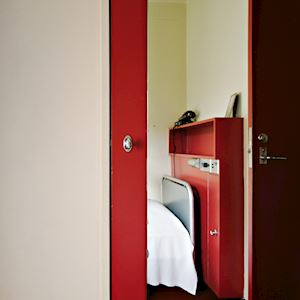
23. Maid’s room/bathroom
The maids had their own bedrooms and a shared bathroom, much as the daughters of the family did. These were smaller and slightly less elegant, and the beds are simpler, but apart from that they’re largely the same. Again, each room has a mirror with lamps on either side of it, a clock, a radio and an internal phone. The bathroom has a separate washbasin for each maid, a substantial bath and a heated towel rail. Mr Sonneveld believed that everyone who lived in the house should have the same comforts, and the luxury afforded to the staff was the talk of Rotterdam. After tea in the evening the maids could go their rooms and listen to the radio or write letters, though they didn't have outside telephones. When they had time off, on Wednesday evenings and alternate Sundays, they had to be in by 10 o’clock. One of them, Jeanne Schreuder, said that when her boyfriend brought her home on his bicycle, Mrs Sonneveld would watch from behind the living-room curtains to make sure she was on time. She was a strict and demanding employer, but Jeanne Schreuder described Mr Sonneveld as “a darling ‘ This is the end of your tour of Huis Sonneveld. Please hand in your audio guide at the counter in the hall. We hope you’ve enjoyed the house itself, and the audio guide.


Sonneveld House is one of the best-preserved houses in the Dutch Functionalist style. The villa was designed in 1933 by architecture firm Brinkman and Van der Vlugt for Albertus Sonneveld, a director of the Van Nelle Factory.
- Museumpark 25
- Rotterdam Netherlands
- 010 440 1200
- nieuweinstituut.nl
